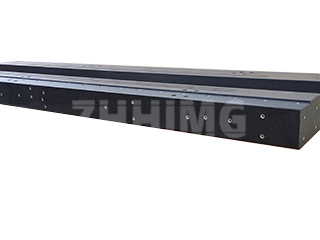Precision granite components, such as CMM bases, air bearing guides, and precision machine structures, are renowned for their inherent stability, exceptional vibration damping, and low thermal expansion. The most crucial factor, however, is the surface itself, which is typically finished to micron or sub-micron tolerances through meticulous lapping and polishing.
But for the world’s most demanding applications, is standard lapping sufficient, or is an extra layer of engineered protection necessary? Even the most inherently stable material—our ZHHIMG® high-density black granite—can benefit from specialized surface treatment to enhance functionality in dynamic systems, moving beyond simple geometric accuracy to engineer the optimal granite-to-air or granite-to-metal interface for maximum dynamic performance and longevity.
Why Surface Coating Becomes Essential
Granite’s primary advantage in metrology is its stability and flatness. Yet, a naturally polished granite surface, while incredibly flat, has a micro-texture and a certain degree of porosity. For high-speed or high-wear applications, these characteristics can be detrimental.
The need for advanced treatment arises because traditional lapping, while achieving unparalleled flatness, leaves microscopic pores open. For ultra-precision motion:
- Air Bearing Performance: Porous granite can subtly affect the lift and stability of air bearings by altering the airflow dynamics. High-performance air bearings demand a perfectly sealed, non-porous interface to maintain consistent air pressure and lift.
- Wear Resistance: While highly scratch-resistant, continuous friction from metallic components (like limit switches or specialized guide mechanisms) can eventually cause localized wear spots.
- Cleanliness and Maintenance: A sealed surface is significantly easier to clean and is less likely to absorb microscopic oils, coolants, or atmospheric contaminants, all of which are catastrophic in a high-precision cleanroom environment.
The Key Surface Coating Methods
While the entire granite component is rarely coated—as its stability is intrinsic to the stone—specific functional areas, particularly critical guide surfaces for air bearings, often receive specialized treatment.
One leading method is Resin Impregnation and Sealing. This is the most common form of advanced surface treatment for high-precision granite. It involves applying a low-viscosity, high-performance epoxy or polymer resin that penetrates and fills the microscopic pores of the granite’s surface layer. The resin cures to form a glass-smooth, non-porous seal. This effectively eliminates the porosity that could interfere with air bearing function, creating an ultra-clean, uniform surface essential for maintaining a consistent air gap and maximizing air pressure lift. It also drastically improves the granite’s resistance to chemical stains and moisture absorption.
A second approach, reserved for areas requiring minimal friction, involves High-Performance PTFE (Teflon) Coatings. For surfaces that interact with dynamic components other than air bearings, specialized Polymerized Tetrafluoroethylene (PTFE) coatings can be applied. PTFE is famous for its non-stick and extremely low-friction properties. Applying a thin, uniform layer to granite components reduces the undesirable stick-slip phenomena and minimizes wear, directly contributing to smoother, more precise motion control and superior repeatability.
Finally, while not a permanent coating, we prioritize Lubrication and Protection as a vital pre-shipment step. A light application of specialized, chemically inert oil or rust-inhibiting compound is used on all steel fittings, threaded inserts, and metallic features. This protection is crucial for transit, preventing flash rusting on exposed steel components in varying humidity conditions, ensuring the precision component arrives in flawless condition, ready for the immediate integration of sensitive metrology instruments.
The decision to apply an advanced surface coating is always a partnership between our engineers and the client’s final application requirements. For standard metrology use, ZHHIMG’s lapped and polished granite surface is typically the industry gold standard. However, for high-speed, dynamic systems using sophisticated air bearings, an investment in a sealed, non-porous surface guarantees maximum performance longevity and unwavering adherence to the strictest tolerances.
Post time: Oct-24-2025

